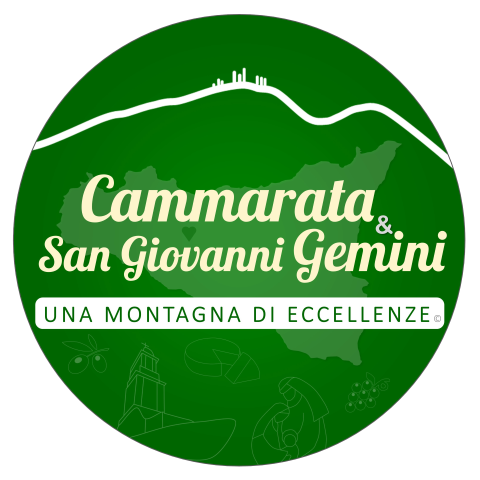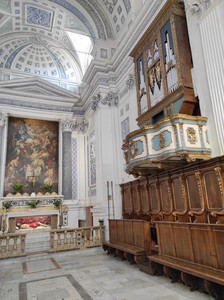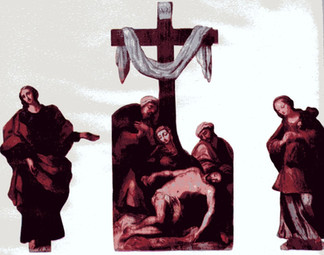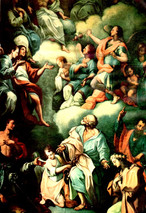Mother Church of Cammarata - St. Nicholas of Bari: History, Art, and Devotion
- Il viandante siciliano

- Apr 24, 2023
- 7 min read

Welcome to our travel blog, where today we will take you on a journey to discover the Mother Church of Cammarata dedicated to St. Nicholas of Bari, a gem of history and devotion that absolutely deserves a visit. Prepare to be fascinated by the beauty of these places and the traditions that make them unique and special.

The Mother Church of St. Nicholas of Bari, an architectural gem: Located on the grounds of the ancient Mother Church destroyed by a fire in 1624, the majestic Mother Church of St. Nicholas of Bari was completed in 1668. This extraordinary church was built on top of two ancient churches, including the Church of the Holy Trinity.
History and artistic treasures: Over the centuries, the church was embellished with refined stucco work created between the 1700s and 1800s by Archpriest Raffaele Rizzo. Inside, numerous works of art are housed, some of which come from the old church, such as the tomb of Prince Blasco Branciforte, who passed away in 1547, and the "Ciborium" by Andrea Mancino, dating back to 1490. The altar was commissioned by Antonio and Isabella Abatellis as the Altar of the Sacrament and houses the magnificent Ciborium, which presents a theological and artistic synthesis around the tabernacle, flanked by angels and topped by a canopy, the four Evangelists, and the Fathers of the Church.
Dominating the upper part is the figure of the Eternal Father, while in the lower part are depicted the birth of Jesus, the crucifixion, the apostles Peter and Paul, and at the center an inscription that narrates the rebuilding of the church in 1642 under Francesco Branciforti. This altar is also known as the Retablo.
Among the works of art preserved in the church, there is the painting of the Buttafuoco from 1598 and other oil paintings from the 15th, 16th, 17th, and 18th centuries. The chapel of St. Nicholas, the patron saint of Cammarata, houses a gilded wooden half-bust of the saint, which contains a relic inside. On the side walls are placed two paintings representing the miracles of the Saint (that of the Cupbearer and that of the three children).
An engraved slate plaque on the left narrates the reconstruction of the church in a more imposing form under Prince Branciforti and the order to preserve a "tabulam" of the Crucifix and St. Nicholas, masterfully painted by the Abatellis in 1664. Inside the church, one can admire a restored organ and a sumptuous Baroque pulpit from the 1600s, commissioned by priest Giuseppe Castellano and made by masters A. Cardillicchia and A. Maggio of Cammarata.
The church also houses the altar of Our Lady of Miracles, with a statue of the Madonna enclosed in a gilded wooden Bramante-style niche, adorned with valuable paintings depicting the birth of Mary and her marriage to Joseph. The feast in honor of Our Lady of Miracles is celebrated on the second Sunday of October, in memory of a grace received by the prince who organized a fair in the streets of Cammarata as a tribute to the Virgin. The feast continues today in San Giovanni Gemini.
In 1663, the canvas by Michele Lapis was created for the altar of St. Calogero, whose feast is celebrated on the second Sunday of August. Devotion to the saint is characterized by the offering of bread shaped like various parts of the human body as votive offerings for healings attributed to the saint. The canvas depicts Ignatius of Loyola and Francis Xavier, while in the background appears the landscape of Cammarata topped by the castle and the village's coat of arms with a woman breastfeeding a serpent and the inscription "alios nutrit suos spernit," which means "nourishes others, despises her own."
In the central nave, there is the tomb of Pietro Panepinto, a benefactor of the church who passed away in 1575; his portrait is preserved in the parish office. Panepinto bequeathed numerous assets to the church, including a water mill, which was partially destroyed. Inside the parish office, a silver urn commissioned by Prince Branciforte is preserved, containing the relics of St. Rosalia. Beneath the altar, there is a statue of a lamb used during Easter to store the Eucharist; the key is kept by the priest and bears the marks of the Passion. In the sacristy, a painting lists all the Archpriests of Cammarata.
The Historic Organ of the Mother Church
The organ of the Mother Church is one of the oldest instruments in Sicily, made in 1506 by Giovanni De Blundo, who also created the main organ of the Cathedral of Cefalù. Over the centuries, the organ has undergone several interventions, including one by Don Gaspare Franco in 1775, as evidenced by a cartouche applied to the lectern. The soundbox retains much of the wooden structure and sixteenth-century decoration.
Probably coming from another church, the organ was modified by Francesco La Grassa, a famous Sicilian organ builder born in Palermo and who died in Cammarata in 1868, perhaps while working on the Mother Church organ. La Grassa was buried in the now-vanished church of San Giuseppe. In the twentieth century, two extraordinary tunings were performed, one in 1905 and another in 1962, when the manual bellows were replaced with an electric bellow.
The current organ consists of 611 pipes, a keyboard with 45 keys, 8 pedals, and 10 stops.
The restoration affected both the instrumental part (pipes, wind chests, keyboard, stops, mechanisms, etc.) and the soundbox with all its decorative parts. Thanks to the careful interventions of the restorers, Professor Giuliano Colletti and Giovanna Comes, the organ of the Mother Church has been restored to its ancient splendor, both artistically and musically, due to its excellent sound quality.
The artworks and sacred furnishings in the Mother Church of Cammarata bear witness to the historical and cultural richness of this place of worship. The architectural elements, altars, canvases, statues, and the historic organ represent an invaluable heritage for the community and all who have the opportunity to visit this church. Celebrations and feasts in honor of the patron saints, such as St. Nicholas of Bari, Our Lady of Miracles, and St. Calogero, keep religious and popular traditions alive, enriching the spiritual and social life of the Cammarata community and its visitors.
The Mother Church of Cammarata, with its centuries-old history and artistic heritage, is a place of great interest for lovers of sacred art, historians, and visitors who wish to learn about the historical and cultural roots of this fascinating Sicilian village. The beauty and importance of this sacred building invite us to discover and appreciate the artistic and spiritual heritage of Cammarata, contributing to the preservation and dissemination of its cultural identity over time.
We hope that this journey exploring Cammarata and San Giovanni Gemini has given you the inspiration to visit these enchanting Sicilian towns and experience first-hand the emotions that only places so rich in history and culture can offer. Don't forget to admire the Mother Church of Cammarata and the other attractions these towns have to offer.
If you are interested in receiving more information, updates, and special offers on travel in Sicily and its surroundings, we invite you to subscribe to our newsletter. In this way, you can stay up to date on the latest news and discover new destinations to explore. Don't miss the opportunity to uncover the hidden wonders of Cammarata, San Giovanni Gemini, and Sicily! Sign up now and start planning your next adventure.

San Nicolò di Bari
Also known as Saint Nicholas, he is one of the most venerated saints in Christian tradition. Born around 270 AD in Patara, in the Lycia region, present-day Turkey, Saint Nicholas was a bishop of Myra, a nearby city. His life was marked by numerous miracles and acts of generosity, earning him the title of protector of children, sailors, and many other groups of people.
Saint Nicholas was the son of a wealthy and devout family. His parents, Epiphanius and Joanna, died during an epidemic when Nicholas was still young, leaving him the heir to a considerable fortune. Instead of enjoying the wealth for himself, Nicholas decided to dedicate his life to the service of others and to the Christian faith, following the example of his parents.
One of the most famous stories about Saint Nicholas's life involves his intervention on behalf of three young sisters who were at risk of falling into slavery or prostitution due to their family's poverty. To prevent this, Saint Nicholas secretly threw bags of gold through their home's window at night, thus providing a dowry for the girls and allowing them to marry and lead a dignified life.
Another miracle attributed to Saint Nicholas is the rescue of three innocent boys who had been unjustly sentenced to death. Saint Nicholas rushed to the governor and managed to persuade him to revoke the sentence, thus saving the young people's lives.
Saint Nicholas died on December 6, 343 AD, and was buried in the cathedral of Myra. Over the centuries, his tomb became a pilgrimage site for devotees from all over the Christian world. In 1087, during Muslim rule in that region, a group of Italian sailors stole Saint Nicholas's relics and brought them to Bari, Italy, where they were subsequently housed in the Basilica of Saint Nicholas, which became an important center of devotion to the saint.
The figure of Saint Nicholas has also influenced the popular Christmas tradition in many countries. Over the centuries, stories about his generosity and miracles have merged with other legends and traditions, giving rise to the character of Father Christmas or Santa Claus, who brings gifts to children on Christmas Eve.
Today, the feast of Saint Nicholas of Bari is celebrated on December 6 in many parts of the world, and the saint continues to be venerated as a symbol of generosity, protection, and love for those in need.

We highly recommend visiting the Mother Church of San Giovanni Gemini, located in the homonymous municipality in the province of Agrigento, Sicily. This church, dedicated to Saint John the Baptist, is an important testimony of religious architecture and the historical-artistic heritage of the area.

Trust our local guides to unveil the hidden treasures of Cammarata and San Giovanni Gemini. With their experience and passion for the territory, they will accompany you on an engaging and fascinating adventure, highlighting the rich history, tradition, and natural beauty of these Sicilian gems.
Our guides will offer you an authentic, personalized, and engaging experience, ensuring an unforgettable journey in these enchanting villages. Don't miss the opportunity to discover all that Cammarata and San Giovanni Gemini have to offer through the eyes and stories of those who live and deeply love these places.
Contact us



























Comments